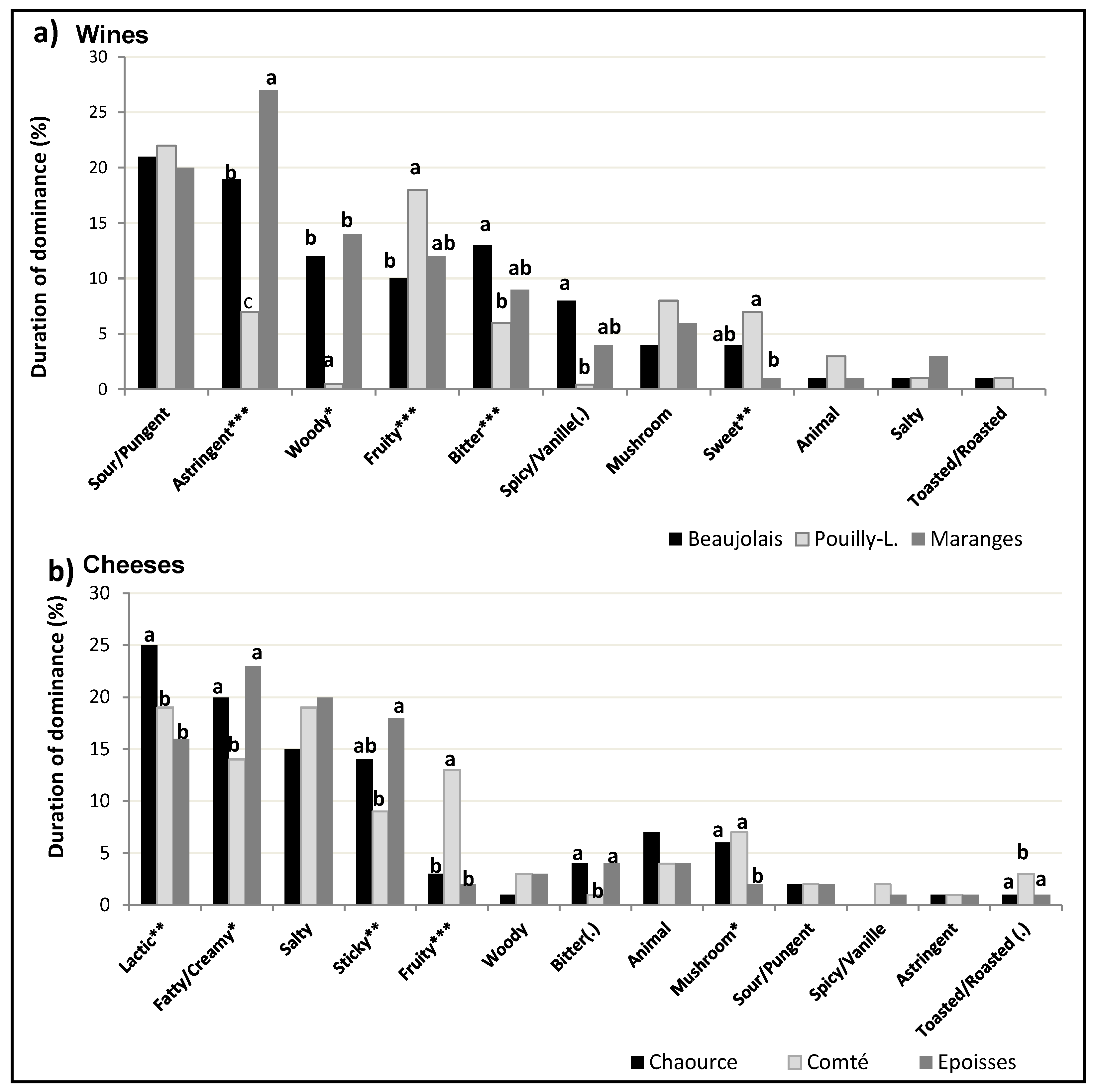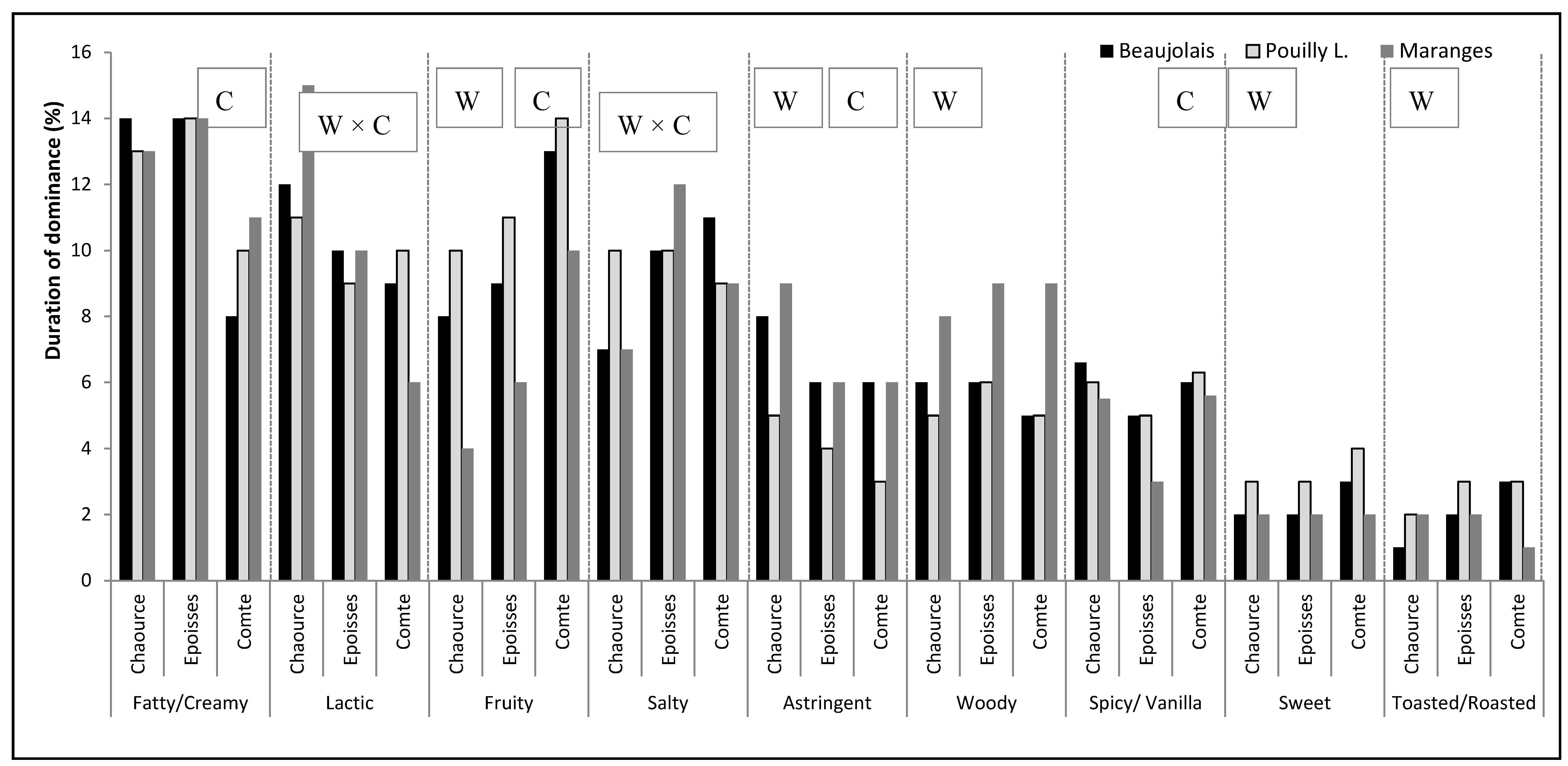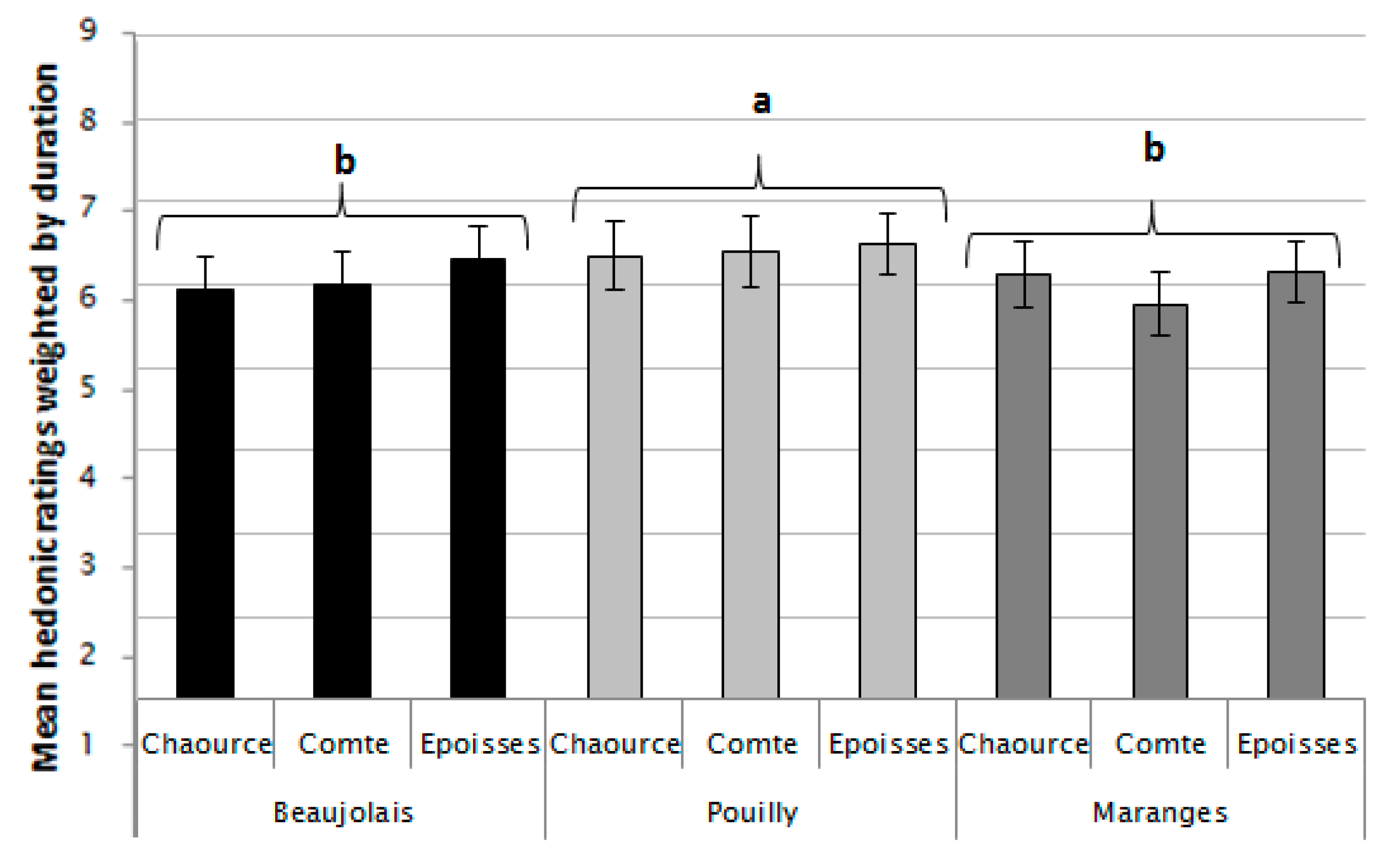3.1. Consumer Behavior in Relation to the Sensory Protocol
Table 4 shows the mean values for the parameters: TBFC, ND and NC for the TDS description, as well as TBFL and NL together with DE for the products tasted in mono-intake. The F-value corresponds to the ANOVA done considering all six products, in order to explore differences between the way consumers evaluated the wines and cheeses.
TBFC was bigger for wines in comparison to cheeses, showing that consumers took more time to choose a given attribute for the wine than for the cheese. The ND was also higher for cheeses, with a mean of 4.4 as opposed to 3.7 for the three wines. In terms of NC, Chaource and Comté had significantly more clicks than Pouilly Loché and Maranges. However, there was no significant difference between Beaujolais and Epoisses, showing that a wine and a cheese can have, on average, the same number of clicks along the tasting.
For the hedonic test, TBFL did not result in a clear grouping of the products, probably related to a higher inter-subject variation. To have a more accurate description of consumers’ behavior towards product rating, the TBFL was compared to the DE (proportion TBFL/DE), showing at which moment of the tasting consumers gave their liking. For Chaource, Comté and Beaujolais, the first liking score was given before the first half of the tasting. For the other three products, consumers gave the first liking score in the second part of the tasting, even after 67% of the tasting time has passed in the case of Pouilly Loché.
It was also found that consumers clicked on the liking scale more than once for every product (mean NC ≥ 2.5), therefore validating the fact that giving several liking scores was possible even when evaluating one intake. For NC, cheeses and wines did not result in two separate clear groups as in the case ND (TDS description). This shows that the number of clicks on the liking scale was independent of the product type and directly related to the individual characteristics of each product.
Comté cheese recorded the most number of liking clicks, while
Maranges was the one with the fewest. However, it should be noted that a change in the number of clicks is not the same as having changes in the dynamics of liking; this will be analyzed in
Section 3.3.
Finally, there were differences in terms of the duration of the evaluation. The evaluation of Comté cheese lasted the longest, while the one for Pouilly Loché was the shortest. However, there was no grouping of cheese vs. wines, showing that the duration of the evaluation was determined by the product itself and not by the product category.
The same type of analysis was done for the evaluation of the wine-cheese combinations with multi-intake TDS-L. Results are presented in
Table 5, together with the effect of wine, cheese and their interaction.
For the TDS evaluation, no significant effect of wine or cheese was observed for TBFC, and nine attributes were used on average, from a list of 15. As for the NC, the combination Comté-Maranges received the least number of clicks, maybe due to the fact that it was the first evaluated combination.
For the hedonic task, between 10 and 12 liking scores were registered, showing that consumers were able to perform the TDS task simultaneously to the TDS description.
Finally, evaluations lasted 3.8 min on average, and there was a cheese effect on the DE; combinations with Chaource were evaluated faster.
3.3. Temporal Appreciation of Wines and Cheeses Individually and Combined
Figure 4 presents the weighted mean liking scores for the wines and the cheeses when evaluated individually. Among the wines, white wine was more liked than the two red wines. The cheeses had higher mean values than wines, but they were all three equally liked. This was probably due to the fact that wines were evaluated blindly; black glasses were provided, and no previous information on the type of wine was given. On the other hand, the type of cheese to be tested was evident for consumers. It is known that information, whether it is on the price [
29], on the label [
30] or the product category, can influence ratings given by consumers. This is particularly so in the case of wine tasting, which is a multi-sensory experience [
31]. This could explain why the wines on their own had lower ratings than cheeses on their own. It would be interesting to repeat the experience, but providing consumers information on at least the kind of product they taste (dry white wine, aged red wine, etc.).
For the combinations, the wine, cheese and wine × cheese effect were studied (
Section 2.4.3). No significant effect was found for the wine × cheese interaction (F = 0.90,
p-value = 0.4639), nor for cheese (F = 1.74,
p-value = 0.1793); but a significant wine effect was observed (F = 7.92,
p < 0.001). This meant that the combinations with white wine had higher weighted mean liking than the combinations with
Beaujolais or
Maranges (
Figure 5), regardless of the accompanying cheese. In this way, white wine would be a more suitable fit for an assorted plate of cheeses. This is in agreement with previous work done by King and Cliff [
2] who showed, using a static “ideal pair” scale that white wines had mean scores closer to ideal than the red wines. The authors stated that white wines (
Sauvignon Blanc Chardonnay,
Pinot Gris,
Gewurztraminer and
Riesling) were easier to pair with a broader range of cheeses. It should be noted that in their work, the evaluation was carried out by wine and cheese experts, while our results reflect consumers’ preferences. However, these scientific findings would be opposed to those presented by Bastian et al. [
5], who in their study found that overall, red table wines were a better accompaniment to cheeses than white wines. This contradiction must be showing that, in fact, it might be quite difficult to stablish a rule of thumb that generalizes in terms of “red vs. white” and that we need to consider narrowing the specter of products before concluding; needing to take a deeper look into what is liked and disliked. In this way, temporal drivers of liking might be a good tool to better understand what makes consumers like a certain product or combination more at a given moment of the tasting.
Table 6 shows that, when evaluated individually, less drivers of liking were found for the cheeses than for the wines. The most outstanding finding for the cheeses was that in
Époisses, salty was a negative driver of liking for 78% of the panel. This meant that when this descriptor was cited, the given score was reduced by 0.18. For the other two cheeses, positive drivers of liking were found, but they were relevant for a smaller proportion of the panel (
Comté: 30% increased their liking by 0.2 when citing mushroom;
Chaource: only 8% increased their liking by 0.29 while citing toasted). This negative perception of salty could be related to expectations regarding the cheese category and not towards the attribute in itself, since all cheeses seem to have the same duration of dominance for this attribute (
Figure 2b).
For the wines, it was observed that astringent, bitter and sour were negative temporal drivers of liking and were found only in the red wines. It should be noted that, even if astringency was a highly dominant attribute when describing
Maranges (
Figure 2a), it was not considered a negative driver of liking in this wine, but it decreased the liking score in the
Beaujolais.
When looking at the combinations, it was observed that the negative TDL were only three and mostly wine related: sour, bitter and astringent. Perception of bitterness made consumers reduce their liking scores in all combinations with Maranges, in two with Beaujolais and only in one with Pouilly Loché (with Comté). The interesting thing is that in every case, this impact was cited by more than half the panel, and ratings were reduced up to 0.47; showing consensus on this dislike. Therefore, probably, a good combination would be that in which the perception of these three attributes is reduced. Sourness also made liking scores decrease, in seven out of the nine combinations with an even higher agreement among consumers, but the reduction in the scores was smaller. Finally, the third negative TDL was astringency, which reduced the scores in four red wine combinations and surprisingly in the Pouilly Loché-Comté combination, where 48% of the consumers reduced their score by 0.34.
Opposite to that, positive TDL were more varied (a total of 10 descriptors) and were related either to wine or cheese. Furthermore, one negative driver of liking in cheese description became a positive one when evaluating the combinations: salty. In Maranges-Comté and Maranges-Époisses, consumers (65% and 83% respectively) increased their liking scores when this attribute was perceived. Actually, Maranges-Époisses was the combination in which salty lasted as dominant for the longest period of time. Therefore, this might be showing that consumers like to perceive the salty taste and the characteristics of the cheese and not for them to be “blurred” by the wine; so, a liked combination would be that in which both the wine and the cheese can be perceived. Furthermore, sticky and lactic were positive TDL for this combination.
The most liked combination was Époisses-Pouilly Loché, which had no negative drivers of liking and had fatty and sweet as positive drivers of liking. The moment fatty was cited as dominant; 95% of the consumers increased their liking score by 0.2, while the liking increased by 0.3 for 43% of the panel when choosing sweet.
It is important to point out that, in the combinations, negative drivers of liking were only three, out of the 14 presented descriptors, and they were repeated in several combinations. However, the positive drivers of liking varied more from combination to combination, having a total of 10 attributes (including “nothing dominates”), which could explain an increase in the liking score.










